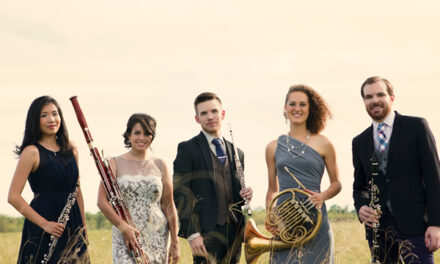While the two works on this evening’s North Carolina Symphony program had little or nothing to do with each other, perhaps it was their lack of similarity which made the concert a memorable one. The program opened with another of the 100th-birthday celebrations of Leonard Bernstein’s music, the Chichester Psalms, and concluded with Maurice Ravel’s complete Daphnis and Chloé ballet music. Both works featured the singers of the N.C. Master Chorale, excellently prepared by their music director, Alfred E. Sturgis.
The number of major choral works intended to be sung in Hebrew is small; perhaps the most significant one before Bernstein’s Chichester Psalms was Ernest Bloch’s Avodath Hakodesh (Sacred Service), a setting of the Jewish Sabbath liturgy. For this reason, mastering Hebrew pronunciation presents an additional challenge to choruses who are used to singing in English and various Western European languages. The Master Chorale met this challenge admirably; their Hebrew was excellent except for the last word, “Amen,” which was pronounced as non-Jews voice it, “Ah-men,” rather than “Ah-main.”* (It may be noted that Bernstein wrote the soprano and alto parts of this work for boys’ voices. In his note to the choral score, he stated that “It is possible, though not preferable, to substitute women’s voices.”)
Bernstein’s score, composed in 1965 on commission from the Dean of Sussex of England’s Chichester Cathedral, is vintage Bernstein, with moods ranging from gentleness (“Hineh mah tov…,” “How good and pleasant it is for brethren to dwell together in unity,”) to dissonant violence (“Lamah rag’shu goyim,” “Why do the nations rage…”). The texts are three complete psalms (100, 23, and 131) plus selected verses from Psalms 108, 2, and 133. From the opening dissonance to the quiet “Hineh mah tov,” conductor Grant Llewellyn brought out the changing moods of this music, reveling in the boisterousness of the rollicking 7/4 rhythm of the opening chorus as well as in the heart-felt closing words from Ps. 133:1.
In the loudest passages, the need for a shell behind the chorus was, as always, obvious. The chorus was not able to match the orchestra’s volume from its position high above and behind the instrumentalists.
Treble soloist (called “boy soprano” in the program) Patrick O’Sullivan, from the Raleigh Boychoir, belied his seemingly-stiff posture by singing the extended solo part of Ps. 23 effortlessly and beautifully. This performance being in Meymandi Concert Hall with its difficult acoustics, he was miked, but the sound system’s augmentation was artfully done so as not to call attention to itself.
Other highlights: the simply gorgeous sound of the orchestra’s interlude leading to the final choral passage in the last movement, and principal ‘cellist Bonnie Thron‘s moving solo in that same Ps. 131 setting.
After intermission, the NC Symphony immersed itself in Ravel’s multi-colored ballet music. Written for Sergei Diaghilev’s Paris ballet company, and first performed there in 1912 under conductor Pierre Monteux, Daphnis and Chloé calls for extra winds (2 piccolos, 3 flutes, and alto flute; 3 bassoons and contrabassoon), two harps, and a bevy of percussion instruments including a wind machine. Then there’s the chorus – but this time, there’s no language problem, because there are no words. Ravel uses the singers as an additional orchestra color.
Listening to this expansive music is much like looking at impressionist paintings by Monet or Manet, where colors are rarely sharply-delineated, but instead blend one-into-another, in constant ambiguity and motion. Ravel’s brush strokes are the orchestra’s bows, the multitudinous cascading flutes, the haunting voices of the English horn, bassoon, and clarinet, the bacchanalian frolics of the brass and percussion sections, and the wordless vocalizations of the chorus. His canvas is the score on which he paints his soundscape. In this score, the sun also rises, conjuring up Debussy’s masterpiece, La mer.
The dimension of musically-impressionist art requires orchestral playing which differs from so much of the standard symphonic repertoire. Llewellyn was in total command, bringing his musicians with him in a superb reading of Ravel’s radiantly-colorful music.
Only one thing was missing: some surtitles which would have told the audience what the music was depicting. These surtitles could be taken from Ravel’s own words, in the printed outline which appears in the score. For example, “A little flame shines suddenly on the head of one of the statues of nymphs. The nymph moves and descends from her pedestal. The second and third nymphs likewise come to life, leave their pedestals and begin a slow and mysterious dance. They perceive Daphnis… weeping for his beloved Chloé, who has been abducted by pirates.”
Or this, describing the final section: “The pantomime is concluded by a sacrifice at the altar of Pan. Then all join in a dance which becomes increasingly wild… Chloé falls into the arms of Daphnis. The ballet ends in a ‘joyous tumult’.” It would help to keep abreast of the story which this music is painting.
Nevertheless, this concert, even lacking dancers, did indeed end in a “joyous tumult” of applause from the audience as they signaled their appreciation for the North Carolina Symphony’s masterful performance.
The concert will be repeated on Saturday, February 10 in Meymandi Concert Hall, and again on Sunday, February 11, in Memorial Hall on the campus of the University of North Carolina at Chapel Hill. See our sidebar for details.
*Updated by the author 2/12/18: My apologies to the NC Master Chorale regarding their pronunciation of “Amen,” which was correct in the now-common Sephardic use. “Ah-MAIN” remains correct in Ashkenazy usage, but that pronunciation has become more rare as the Sephardic has taken its place in most U.S. Jewish liturgical use.











